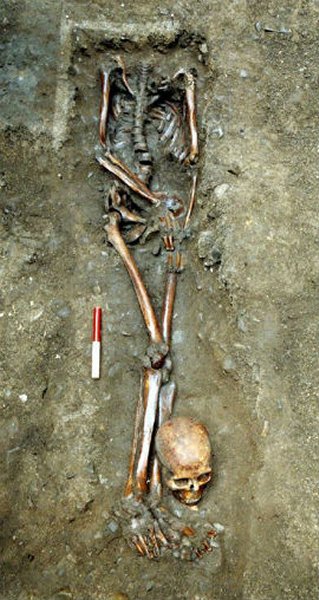MessageToEagle.com – University of York archaeological scientists were part of an international team that used cutting edge genome technology to cast more light on an ancient mystery that has long puzzled archaeologists.
Now, Irish-based geneticists have revealed the secret past of bodies buried in a cemetery dating back to Roman times in York, England.
One of the surprising discoveries in an analysis of the remains by Trinity College Dublin scientists was the beheaded body of a migrant from the Middle East, who was found amidst the early Britons.

Much unknown history has emerged as a result of the DNA genome analysis of the remains, which was led by Prof Dan Bradley, professor of population genetics at Trinity, reports The Irish Times.
It was already known that the 80 skeletons buried in the Roman cemetery had a martial history, given that all had healed injuries consistent with battle trauma.
However, it was not until the genome analysis of seven of them was completed that the Middle Eastern origin of one was exposed.
“There were clear signs of a martial history for these people,” said Prof Bradley, who is based in Trinity’s school of genetics and microbiology.
“All of the bodies show signs of healed damage to bones. Nearly all of the 80 were males, all were about 45 years of age and all were taller than usual.
“All were decapitated, with their heads taken off just before natural death overtook them. This suggests they were gladiators or possibly soldiers.
“It is still not clear why they were all decapitated. Maybe that was an end of life event for gladiators,” he said.
The bodies were found a decade ago by the York Archaeological Trust at Driffield Terrace in the city.
Analysis had shown that all of the bodies suffered childhood deprivation and had recovered from injuries.
It had also shown that the burials were similar to those in a Roman burial ground believed to be for gladiators at Ephesus, Turkey.
Who they were and where they came from remained a mystery, until Prof Matthew Collins of the University of York approached Prof Bradley, who had recently published the first prehistoric Irish genomes with Rui Martiniano of Trinity, and the two immediately agreed to deliver the first prehistoric British genomes from the York site.
Mr Martiniano is lead author of the Nature Communications paper that tells the story of the bodies.
Genomic analysis
“The only way to learn about the past is to sample from the past, and the only way to do that was through genomic analysis,” Prof Bradley said.
One of the seven bodies analysed was from the Palestine/Jordan/Syria region and was determined to be a migrant to the northern-most Roman capital city, he said.
“It is crystal clear from the genetics. He had his origins in the Middle East and met his end in York.”
Six were genetically similar to other Britons of the time, which was several centuries before the arrival of the Anglo-Saxons about 600AD.
The six bodies were genetically closer to the modern Welsh than to the later Saxons, Prof Bradley said.
The study showed that five would have had brown or black hair and brown eyes, but one had different roots and would have had blue eyes and blond hair.
“It confirms the cosmopolitan character of the Roman Empire even at its most northerly extent,” he said.
MessageToEagle.com
source: The Irish Times






